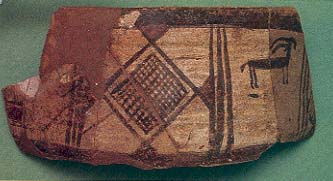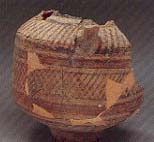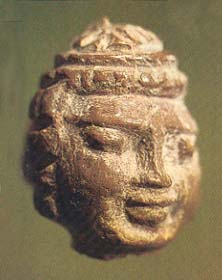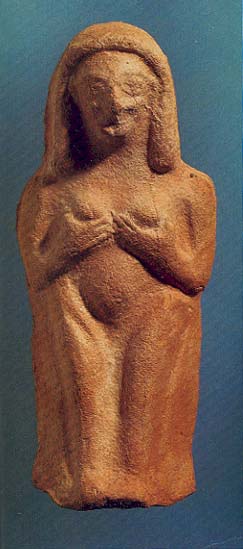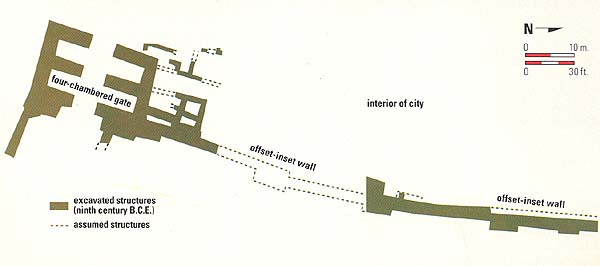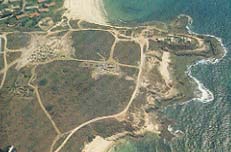
Tel Dor, on Israel’s Mediterranean coast, is the site of one of the most conquered cities in the Levant. Although practically every major people of the region occupied or ruled the site at one time or another—leaving behind an accumulation of debris 45 feet high—it was the Phoenician culture that dominated Dor for some 800 years. Twelve years of excavation at this site 12 miles south of Haifa have revealed a wealth of remains and new discoveries, now presented by Ephraim Stern, director of the Dor excavation, in this three-part article.
In “The Many Masters of Dor, Part 1: When Canaanites Became Phoenician Sailors,” BAR 19:01, Stern traced Dor’s history from its Canaanite roots in the 20th century B.C.E. through its conquest and occupation by the Sikils—a Sea People tribe—up to its reconquest by the Phoenicians in about 1050 B.C.E. In this installment, he tells the story of the Phoenician-Israelite city, its development as a major port and its fall to the Assyrians in 733 B.C.E. “The Many Masters of Dor, Part 3: The Persistence of Phoenician Culture,” BAR 19:03, will look at the succession of absentee landlords—Assyrian, Babylonian and Persian—who ruled Dor until the city’s complete Hellenization in the third century B.C.E.
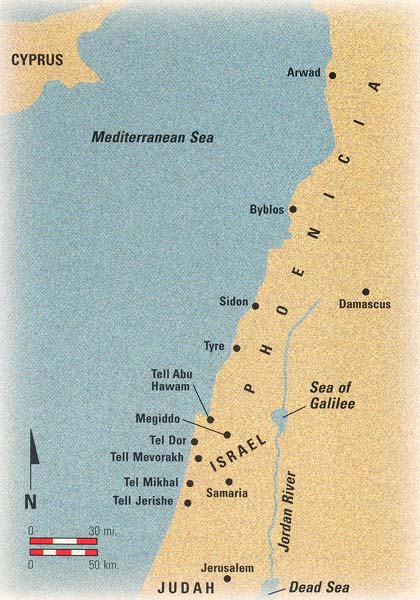
The Phoenician city that arose on the ruins of the Sikil city was not simply prosperous, it expanded both on the east and on the south. (By that time the sea had already eaten away at the western side of the city.) The new city walls were built on the outer slope of the rampart that the Sikils had amassed outside their city wall. Later the city also expanded to the north.
Excavation of the tell proved especially difficult because it had been continuously cultivated, and many of the exposed or partially exposed stones had been almost incessantly plundered. As a result of illegal excavations on the eastern slope, the incline to the tell is very moderate, despite its once great height.
In addition to the expansion of the tell that I have described, there also was at one time a great “lower city.” Almost nothing is known of this lower city. In my opinion, it extended nearly a mile to a sandstone ridge on the east, which apparently served as the city’s principal burial ground and, in some periods, also as the main source of its building stone. Remains of plundered hewn graves and quarry sites have been found here in abundance. The earliest stratum of the lower city so far exposed dates from the Hellenistic period (and is therefore beyond the scope of this article), but earlier remains may be uncovered in the future.
Phoenician Dor was at least the equal of the four major Phoenician cities—Byblos, Tyre, Sidon and Arwad—in both size and importance. But in contrast to these other major Phoenician cities, Dor’s outstanding state of preservation affords an unparalleled opportunity to study a major Phoenician harbor town on the eastern Mediterranean coast, from the beginning of Phoenician development in the late 11th century B.C.E.a to its end in the late Hellenistic period (64 B.C.E.). After 12 years of excavation, we can state with confidence that this is the largest Phoenician city in a good state of preservation.
We have uncovered the remains of the first Phoenician city at Dor—the one that succeeded the Sikil or Sea People city—in only a few places (principally in our area B1). It dates to the late 11th century B.C.E. and has been exposed only in an area about 35 by 70 feet. Here we found several long walls built mostly of mudbricks and have traced them for lengths up to 45 feet. As far as we can judge from the fragmentary remains uncovered, the structures were large and must have been public buildings, probably standing near the city’s eastern gate. This gate must be buried beneath later gates, and we have not yet found it. Within the structures, we found interior walls that subdivided the space. Between these dividing walls and the outer walls was a complicated series of closely superimposed clay floors.
These buildings extended only as far as the inner edge of the Sikil rampart. This probably indicates that this rampart was still used as a major defensive barrier by the earliest Phoenician city.
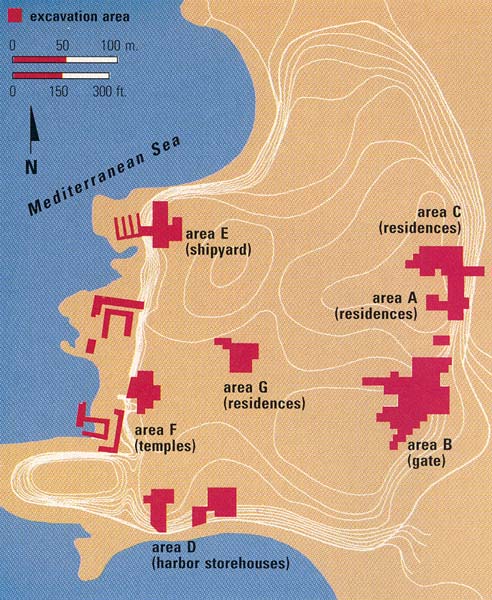
On the floors of these buildings, we found Phoenician bichrome potsherds of the earliest types known. We also found an assemblage of Cypriot white-painted and bichrome sherds that are rare in Cyprus and even rarer in Palestine and on the Phoenician coast to the north. Fortunately, these sherds are securely dated to the second half of the 11th century B.C.E., thereby providing an excellent chronological indicator for dating this stratum at Dor.

Less important to the archaeologist, but more beautiful, are two other finds imported from Cyprus: an ivory plaque engraved with a classical Cypriot motif—a bull goring a lotus flower—and a cylinder seal depicting dancing men, bulls and weapons.
How should we interpret this mixture of Phoenician and Cypriot elements? The Cypriot vessels could of course simply be the result of trade links. It is more likely, however, that the trade was internal between the Phoenician inhabitants of Dor and those of Cyprus. Studies of the distribution of Phoenician pottery on the island of Cyprus reveal that it has been found not only on the eastern side of the island, but also on the far western side. Patricia Bikai, who has studied the date and distribution of this pottery, suggests that the first Phoenician settlements on Cyprus were already established by the second half of the 11th century B.C.E.1 Thus the trade reflected in the Cypriot materials from this Phoenician city at Dor may have been internal trade between Phoenicia’s earliest colonies and the mainland.
The Phoenician rule of Dor did not last long. The Bible makes it clear that this area was conquered by King David. In the summer of 1992, we reached a section (in our area G) of the floor of the Phoenician city that David conquered; there amid the other evidence of destruction was the complete skeleton of a woman whose head had been crushed by a stone, apparently a casualty of the battle. (See “A Death at Dor,” in this issue.)
David brought the entire northern Palestinian coast under direct Israelite control. According to the census conducted by David, the northern border of Israel extended nearly to Tyre and Sidon (2 Samuel 24:6–7). Dor would then have been quite far south of Israel’s northern border and an integral part of David’s kingdom. David may even have made some grants of land in the Dor vicinity to Israelite settlers who came from inland areas.
King Solomon developed close ties with Hiram, king of Tyre. However, two Biblical passages relating to the transfer of cities seem to conflict. In 2 Chronicles 8:1–2, we are told that Solomon “rebuilt the cities that Huram [Hiram] had given to him.” In the parallel text in 1 Kings 9:11, we are told that Solomon gave 20 towns to Hiram in gratitude for his help in building his palace and the Temple to the Lord. (See “Cabul—A Royal Gift Found,” in this issue.)
The apparent conflict can be resolved by the following sequence of events: During the first half of Solomon’s reign, the northern border of his kingdom extended all the way to the southern border of Phoenicia proper. In the second half of his reign, he ceded back to Phoenicia everything north of the Carmel coast. At that point, Dor remained in Israelite territory, just south of the new northern border. No doubt Solomon settled some Israelites in this area. As the Bible records, “Solomon … settled Israelites in [these formerly Phoenician cities]” (2 Chronicles 8:2).
Later, after returning the area north of the Carmel to Phoenician control (the population there was mostly Phoenician anyway, as indicated in several recent excavations north of Dor), Solomon organized the remaining territory into 12 districts. Dor became the capital of the fourth district. According to 1 Kings 4:11, the district of Dor was governed by Solomon’s son-in-law—married to his daughter Taphath. His name, however, is given only as ben-Abinadab, the son of Abinadab. Thus we know the man’s father’s name, but we do not know his name. Incidentally, this same form of personal name is also found on a Phoenician ostracon (from the Persian period, however) excavated at Dor; this ostracon bears a list of several names, all written in the same form: “son of X.”
The Bible notes that two of the 12 district governors were Solomon’s sons-in-law; as applied to the ruler of the district of Dor, this is probably the Bible’s way of indicating the city’s importance.
Dor flourished during the reigns of King David and King Solomon, as did the entire Sharon and Carmel coast. This has been established by excavations at a number of sites in the area—Tell Jerishe, Tell Qasile, Tel Mikhal, Tel Mevorakh, Shiqmona and Tell Abu Hawam, as well as at Dor. Both David and Solomon maintained close ties with the cities of Phoenicia, especially Tyre, which at this period were all that remained of the territory formerly known as Canaan. Phoenicia, as it has now become known, was confined largely to the modern Lebanese coast. Yet it preserved the knowledge and expertise acquired by the Canaanites in the course of the second millennium—in art, construction, metalwork, seal carving, wooden furniture making, weaving, the use of purple dye, shipbuilding and seafaring. Phoenician influence undoubtedly helps to account for the prosperity of the area in David and Solomon’s reigns. In addition, both David and Solomon encouraged the development here of ports and maritime trade, with and without the cooperation of the Phoenicians, for this was the only portion of the coast under the exclusive control of the Israelite kingdom. During the United Monarchy, Dor became Israel’s principal port; it was through Dor that Israel maintained its commercial ties with neighboring Tyre and other Phoenician cities.
As for the Phoenicians, although at first they expanded by military force in northern Palestine, destroying the Sikil city of Dor as well as other sites in the area, they soon learned to expand instead by commerce and colonies. Thus their expansion farther south along the coast was peaceful, by means of trade. This strategy benefited both peoples.
Even after David’s conquest of Dor, the city continued to be inhabited mostly by Phoenicians, and their culture remained dominant; this continued to be the case after Solomon gave (in other words, returned) to Hiram the territory north of the Carmel range. Indeed, the Phoenicians continued to inhabit Dor for centuries under a succession of foreign rulers—after the Israelites came the Assyrians, then the Babylonians, then the Persians and then a series of Hellenistic rulers starting with Alexander the Great (332 B.C.E.) and continuing with the Ptolemies (300–200 B.C.E.), one of whom, Ptolemy II, Philadelphus (283–246 B.C.E.), put an end to the Phoenician character of the city and rebuilt it on the Greek model.
From the archaeological evidence, we would not know that the Israelites under David and Solomon controlled the area around Dor (even after Solomon gave Hiram of Tyre 20 cities north of Dor). The Biblical record leaves no doubt that this was the case, but this is not apparent from the material culture unearthed so far. This shows that despite Israelite control, most of the area continued to be populated by Phoenicians, or perhaps that the local Israelites adopted Phoenician culture.
Upon Solomon’s death, his kingdom split in two—Israel in the north ruled by Jeroboam and Judah in the south ruled by Rehoboam. All this time Dor, although Phoenician in culture, remained in Israelite hands. In 925 B.C.E., the fifth year of Rehoboam’s reign, however, Pharaoh Shishak of Egypt invaded Judah and Israel and ravaged large areas (1 Kings 14:25). Worst affected were the Shephelah, the Jezreel Valley and the Beth-Shean valley. The route of Shishak’s military campaign is recorded in a long inscription found in his temple at Karnak, which adds several details to the brief Biblical description. Shishak also erected a victory stela at Megiddo, part of which was found in the excavation of that site. This stela confirms that Shishak captured and destroyed Megiddo. I believe that the destruction of the United Monarchy city of Dor was also Shishak’s work and that this Israelite port suffered the same fate as Megiddo and Beth-Shean.
Evidence of Shishak’s destruction of the cities of the Sharon coast is gradually becoming clearer and clearer as more and more sites are excavated. My own small site of Tel Mevorakhb was destroyed at this time and was not rebuilt for 500 years. This seems to have been the case at other sites as well—at Tell Jerishe, on the banks of the Yarkon River; at Tell Qasile, farther down the Yarkon; at Tel Mikhal, south of Dor; and at Tell Abu Hawam, north of Dor, near the estuary of the Kishon River.
Unfortunately, the archaeological evidence of the United Monarchy at Dor is about as meager as the evidence of the previous city, the earliest Phoenician city at Dor that arose on the ruins of the Sikil or Sea People city. We did, however, find part of the city wall from the United Monarchy, which passes under a later gateway (the so-called four-chambered gate of the Divided Monarchy).
Several traces of walls and floors from residential buildings of the United Monarchy period have also been found. It is clear from this material that already in the tenth century B.C.E. the city’s buildings were built in the well-known Phoenician-Israelite style—that is, with walls consisting of intermittent hewn pillars with uncut fieldstone fill in the spaces between the pillars. We have uncovered enough of this area to be able to say that the city of Dor during the United Monarchy was carefully laid out with streets at right angles.
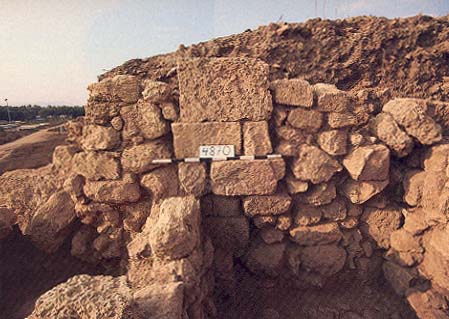
The ceramics include imported Cypriot pottery found alongside the usual local ware, as well as Phoenician bichrome ware and the Cypro-Phoenician pottery known as Red-on-Black ware. This period also marks the first appearance of red-slipped burnished vessels, mostly jugs and juglets but also including some delicate thin-walled bowls that later became the hallmark of the entire Phoenician world. This pottery is known by different names—either based on its color (red-slipped ware) or based on sites at which it was first found in considerable quantities (Akhziv ware or Samaria ware, etc.).
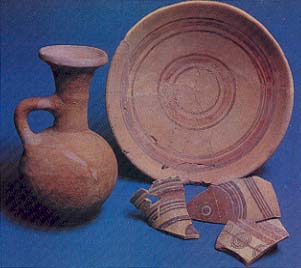
As we have seen from David to Shishak, Dor was formally a part of the Israelite empire, although it was on the northern border in the latter half of Solomon’s reign. Despite this formal connection with Israel, the city remained essentially a Phoenician city—at least it had a large Phoenician population and was in many ways dominated by Phoenician culture. If this was true during the United Monarchy of David and Solomon, it was also true of Dor during the Divided Monarchy.
Despite the devastation wrought by Shishak’s lightning campaign, Egypt did not annex any territory. His campaign was mainly to take spoil and to bring local rulers under the Egyptian sphere of influence.
Dor of the Divided Monarchy was also a well-fortified city. In this stratum, we have found the city gate on the eastern side of the City. The great stone base consists entirely of huge limestone blocks. This base originally supported a mudbrick superstructure, but all that remains today is the base. We call this the four-chambered gate because it had two chambers on each side, created by a pier that divided the space in half. In its original state, each pair of chambers was the lowest level of two entrance towers that flanked the gateway itself.
The huge blocks of limestone from which the city gate was constructed were probably brought from the Carmel ridge nearly a mile to the east. Some of the limestone blocks in this gateway structure are almost 5 feet long and 3 feet high. The walls of the gateway are more than 6 feet thick. The entire gateway structure is nearly 70 feet wide and almost that deep. This was truly an impressive structure.
The passage through the gate, between the two chambers on each side, was paved with crushed sandstone. A plaza paved with small stones lay in front of the gate. A stone-paved road led to an outer gate, located to the northeast of the inner, four-chambered gate. Thus far we have excavated only a small part of the outer gate. And even some of the details of the inner gate remain unclear—for example, whether it had one or two pairs of doors. This uncertainty exists because we have not yet exposed the entire structure. To do so, we would have to remove the two-chambered gate above it and the gates above that, all from later periods.
In each of the eastern chambers, on both sides of the gateway, we found a rectangular stone basin, which fortunately survived the destruction of the four-chambered gate and was incorporated into the two-chambered gate, perhaps because they were made of stone. Basins of this type have also been found in other gates of the period (such as at Gezer) and have been interpreted as water receptacles for both men and animals; they served either those coming to the city or, more likely, the gate’s garrison.
On one of the inner sides of the gate, facing the City, we found a row of seven decorative orthostats (well-hewn and smoothed stone slabs), each of which is about 5 feet high and 3 feet wide.
Excavating this city gate has not been easy. As already indicated, several gates from later periods are above it. One of the four chambers was entirely destroyed by pits dug during the Persian period (sixth–fifth centuries B.C.E.). And under this gate runs an earlier (tenth century B.C.E.) wall. The four chambers had two different floors in different phases. When I we found them, they had been covered with sand and other material by later builders. In this fill, we found sherds from the 11th century B.C.E. and a faience seal in the shape of a lion, with the cartouche of Pharaoh Tuthmosis III (1490–1436 B.C.E.) on the back. If this sounds confusing, it can look even more confusing out in the field as one uncovers it inch by inch.
Adjoining the gate on each side was a solid offset-inset city wall, the base of which was built partly of mudbricks and partly of stone (with no logical order). A clay glacis covered with plaster was built against it.c
Beneath the gate, we found remains of walls and buildings that contained late tenth-century sherds. Stratigraphically, the situation is clear: The gate had to have been built after that date—after Shishak’s destruction of the city in 925 B.C.E. South of the gate, we found a plaster floor that reached as far as the gate, and on the floor lay late eighth-century sherds. On a similar floor on the west, we found traces of destruction by a fierce conflagration, including ash and the remains of charred wood that probably came from the gate’s superstructure; here too lay sherds from the late eighth century B.C.E. Again the stratigraphic situation is clear: The Divided Monarchy city gate was destroyed in the late eighth century B.C.E. There is no difficulty finding a cause for this destruction. Only a very powerful enemy could have destroyed a city defended by such powerful fortifications: the Assyrians.
In 733 to 732 B.C.E., Assyrian armies led by King Tiglath-pileser III ravaged Israel for the first time. Both the Bible and Assyrian sources provide the scenario. First, the Assyrians conquered the Galilee and the Jezreel Valley in the northern part of the kingdom of Israel. Then the Assyrians proceeded to the northern coast—to Dor and the Sharon plain—leaving a destroyed Dor in their wake. Before completing the conquest of the northern kingdom (Israel), however, Tiglath-pileser III had to return home to wage war against the Babylonians, who at that time rebelled against him. He never again returned to the West. He was succeeded by his son Shalmaneser V (726–722 B.C.E.). He too campaigned in Israel and in 722 B.C.E. destroyed Samaria, the capital of the northern kingdom. This marked the end of the kingdom of Israel. The Israelite population was exiled, never to be heard from again; the ten Israelite tribes whose territory composed the northern kingdom became known as the Ten Lost Tribes. It is in this context that we must place the destruction of the Divided Monarchy city of Dor.
But we are getting a little ahead of the story. We know who destroyed this city. But who built the impressive fortifications that only an empire as powerful as Assyria could destroy?
To answer this question, we are going to take an excursion to nearby Megiddo. Megiddo was excavated in the 1930s by an American team from the University of Chicago, which almost completely uncovered the mound. The city at Megiddo (stratum IVA) that corresponds to Divided Monarchy Dor was extremely large and was surrounded by a wall with a gate whose plan is identical to the four-chambered gate at Dor. Both gates were built to the same design. They were probably the work of the same architect.
At Dor we have concentrated on the outer fortifications of the city; only a small part of the city itself has been investigated, and we know very little about the city’s residential buildings or its plan. At Megiddo, however, the excavators exposed the interior of the city as well. In addition to the fortifications, they also excavated two large complexes of stables capable of housing about 450 horses,d an impressive water system and important public buildings. The American excavators initially attributed this city to King Solomon, but on reexamination, Yigael Yadin concluded—and I agree—that it was built by Ahab, a king of Israel who reigned about 100 years after Solomon—from about 874 to 853 B.C.E.
Other Israelite cities with similar impressive buildings have been excavated since the excavation of Megiddo—Hazor, Dan, Beth-Shean and, very recently, Jezreel. At each site, archaeologists found massive fortifications and monumental buildings from the ninth century B.C.E. Special mention should be made of Samaria, the capital of the kingdom of Israel, because in addition to its impressive fortifications, excavators recovered the famous palace (probably Ahab’s) that contained the remains of the “ivory house,” where the Samaria ivories were found. You will recall that the Bible refers to Ahab’s “ivory palace” (1 Kings 22:39). (The eighth-century prophet Amos excoriated those in Samaria who “lie on ivory beds … feasting on lambs” [Amos 6:4] and predicted the destruction of its “ivory palaces” [Amos 3:15].)
I have no doubt that when other Israelite cities are excavated, similar monumental buildings that can be attributed to Ahab will be discovered.
The Bible does not have much good to say about Ahab because he married Jezebel, the daughter of Ethba’al, king of the Sidonians. Recently the seal of this Phoenician queen, who had such an effect on Ahab, may have been found; carved in strikingly Phoenician style, it is inscribed with the name Jezebel. Under his wife’s influence, Ahab even built a temple to Baal in Samaria. But despite its negative assessment of his reign, the Bible acknowledges “all the cities [or, in some translations, fortifications] that [Ahab] built” (1 Kings 22:39).
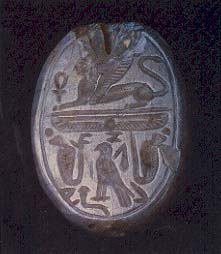
Ahab was also a great military leader. The Bible tells us of his wars against the Arameans and against Ben-hadad, king of Damascus, whom he finally defeated. He thus forced Ben-hadad to give him markets in Damascus (1 Kings 20, especially verse 34).
Another aspect of Ahab’s military prowess is recorded in Assyrian records. Ahab joined a coalition of states that halted a major Assyrian advance into Syria in 853 B.C.E. at the famous battle at Qarqar on the Orontes River. According to an inscription of Shalmaneser III (858–824 B.C.E.), who led the Assyrian troops, the allied coalition of 12 kings was headed by the king of Damascus (Ahab’s old enemy) and the king of Hamath. Other units were furnished by various kings of Syria and Phoenicia. Supporting troops even came from Egypt and Arabia. Ahab was right there as one of the leaders with the kings of Damascus and Hamath. The king of Israel apparently did not hesitate to confront the powerful Assyrians. Indeed, Ahab supplied 2,000 chariots, more than any other member of the coalition (Damascus supplied 1,200, and Hamath, 700). Ahab also contributed 10,000 infantry troops to the coalition (the same number as Hamath; Damascus contributed 20,000).2
It is surprising that none of this is mentioned in the Bible. The reason may be that the Biblical author so thoroughly disapproved of Ahab that he did not want to praise him for his military accomplishments. Perhaps inevitably, or perhaps perversely, I have developed a certain fondness for this usually despised king of Israel. Not only was he a great builder, he was also a military hero who died a hero’s death. In one of the wars that Israel and Judah waged against Aram, Ahab was mortally wounded. Fearful that his troops would retreat if they saw this, Ahab refused to leave the field of battle; instead, the Bible tells us, in a passage of grudging admiration, Ahab had himself “propped up in [his] chariot facing Aram [while] the battle raged all day. The blood from the wound ran down into the hollow of the chariot, and at dusk he died” (1 Kings 22:35).
Ahab’s extensive military involvement obviously demanded well-fortified cities and an administration that could raise and manage a large army. No doubt, the creation of chariot cities (where large chariot forces were based), such as Megiddo, was one of the foundations of Ahab’s administrative policy.
On the basis of all this evidence, it seems reasonable to conclude that Ahab was the builder of the Divided Monarchy city of Dor with its four-chambered gate and offset-inset wall—and of Samaria, Beth-Shean, Hazor, Dan and Jezreel as well.
Although we have not yet excavated extensively inside Dor and know little of its buildings or internal organization, we can predict that the buildings from this period at Dor will be no less magnificent than those discovered at these other cities, especially Megiddo and Samaria. In some ways Dor may be even grander. We have already noted the similarity between the four-chambered gates at Dor and at Megiddo; the plan is identical. The gate at Megiddo is slightly larger than that at Dor, but the construction at Dor is far more magnificent. The Megiddo gate was constructed by Israelites using relatively small stones. In contrast, the gate at Dor was probably built by Phoenician masons, the finest builders of the time, who employed their own special style: They used huge, well-hewn limestone blocks brought from the Carmel cliffs. If the gates of the contemporaneous Phoenician coastal cities—Arwad, Byblos, Tyre and Sidon—are ever discovered, they will no doubt display this same massive manner of construction.
Ahab’s extraordinary construction campaign in so many cities of his kingdom will inevitably invite comparison with Herod the Great (37–4 B.C.E.), the greatest of the builder-kings of Israel. In light of the accumulating archaeological evidence, Ahab may well be described as the greatest of the builder-kings of Israel between Solomon and Herod.
Other aspects of Ahab’s personality are also reminiscent of Herod: Although both were great builders, they were not otherwise admirable men. More pertinent here: Just as Herod built a harbor at Caesarea, so Ahab rebuilt Dor as a great fortified port.
Ahab needed a large harbor near the Phoenician centers so that he could cooperate with the Phoenicians in maritime trade and undertake joint trading voyages. The old harbor at Dor with its bays proved an ideal base on which to build. I believe that the central bay, which was extensively developed in the Hellenistic period, was first developed in Ahab’s time; the area of the central bay generally resembles the inner harbor (kothon in Phoenician) found at other sites in the western Mediterranean, such as Carthage in North Africa and Motya in Sicily. This central bay may have been used for shipbuilding. The nearby Carmel forests could easily have provided the raw material. In the last few seasons, near the southern harbor (in area D2), we came upon and 6 feet thick. The building is probably a storehouse associated with the harbor. Even though we have not finished excavating it, it is already clear that this is one of the largest buildings of the period ever discovered in Israel.
Like the Phoenicians, the Israelites were experienced sailors at this time. This is reflected in a rarely noted passage in the Bible. When a Judahite ship was wrecked at Ezion-Geber in the south, Ahab’s son Ahaziah offered to have his Israelite sailors man the ship in cooperation with the Judahites, presumably to prevent future wrecks (1 Kings 22:48–49 [49–50 in Hebrew]).
Another reflection of Israel’s seafaring ability is a recently published seal with a complete ship on it that closely resembles contemporaneous Phoenician ships depicted in Assyrian reliefs. Professor Nahman Avigad, who published this seal, describes the ship as Israelite-Phoenician, perhaps of the “Tarshish” type, whose home port may have been Dor.3 The ship on the seal may have identified the owner as belonging to a family of sailors or, more likely, shipowners. The name on the seal, “Oniyahu son of Merav,” hints at this; in Hebrew, oniyahu means a ship, or even a ship of Yahweh, Israel’s god.
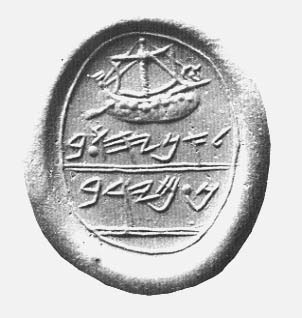
At this time, in the ninth century B.C.E., the border between Israel and Phoenicia was undoubtedly open and free. Elijah, for example, could freely travel to “Zarephath [Sarepta] of the Sidonians” and remain there for an extended period of time (1 Kings 17:8–24).
Phoenician influence at Dor was also felt in the religious sphere. As previously noted, Ahab, under Jezebel’s influence, built a temple to Baal (1 Kings 16:31–33). The well-known contest between Elijah and the 450 prophets of Baal took place on Mt. Carmel, only a few miles from Dor (1 Kings 18:19–40). Phoenician priests who served in Baal’s temple at Dor may well have been among those who perished in the contest.
Our finds also include several figurines of the goddess Astarte (Ashtoreth), which may have been associated with the temple of Baal.e We also excavated a rare clay mold used to produce some of these figurines. The goddess is depicted naked, with her hands supporting her breasts.
These Astarte figurines were molded in a style characteristic of Phoenician tradition. They are very different from the Astarte common in Judah and Philistia. In details their heads more nearly resemble the Egyptian goddess Hathor; their bodies are usually made as plaques—that is, molded in front with a plain, flat or hollow, back. By contrast, Astarte figurines from Judah and Philistia are often handmade rather than made in a mold. Worship of the local Baal and Astarte was widespread among the entire population, both Israelite and Phoenician, as the Bible itself acknowledges (see, for example, 1 Kings 16:31–33).
At least one temple at Dor was dedicated to the Israelite God. We know this from a Hebrew seal discovered before our excavation began. Now in a private collection, it was supposedly found “near Samaria.” It is inscribed in old Hebrew letters—the kind used before the Babylonian Exile: “(Belonging) to (Ze)kharyau, priest of Dor.” That the seal’s owner had a Yahwistic name (the suffix yau is an abbreviated form of the name Yahweh, the personal name of the Israelite God) indicates that he served in a temple dedicated to this God.
During the Divided Monarchy, the kings of the northern kingdom erected temples in their principal cities in order to draw their citizens away from the Temple at Jerusalem. Especially important were the temples at Bethel and at Dan (1 Kings 12:28–33). The remains of the temple area of Dan have recently been uncovered in an excavation led by Avraham Biran.f The Bible does not mention a temple at Dor, but other temples of Yahweh apparently existed in both Israel and Judah, even though they are not mentioned by name in the Bible. According to Professor Avigad, who published the “priest of Dor” seal, the temple at Dor “may have been built by Rehoboam, but it seems more likely that it was erected during the rebuilding of the city at the time of the Omri dynasty—or, more precisely, in the reign of Ahab.”4 We hope that one day we will locate and excavate the Israelite temple at Dor.
Despite the priest of Dor’s Yahwistic name, it is highly likely that the cult of the temple incorporated Phoenician elements—a female deity as well as a male deity was probably worshiped in this temple. At the contemporaneous Israelite temple at Kuntillet ‘Ajrud in the Sinai, Phoenician inscriptions were found alongside Hebrew inscriptions. One of the Hebrew inscriptions mentions “lyhwh smrn wl’ srth” (Yahweh of Samaria and his asherah). It is likely that the temple at Dor was also dedicated to this pair. When—eventually—we do find the temple of the Yahwistically named priest of Dor, we will probably find in addition numerous figurines of the Astarte type described above. Until that time, we will have to console ourselves by producing “homemade” copies of these figurines in the mold we found and presenting them as souvenirs to expedition members and guests.
Ivory carving was one of the most highly developed Phoenician crafts, and it is clear that the Phoenicians passed on their knowledge to the inhabitants of the kingdom of Israel. Ivories were generally of two types: larger pieces that were applied to walls and to furniture and smaller objects forming all or part of boxes, incense and cosmetic spoons, and knife and sword handles. Among our finds was a small (less than an inch high) woman’s head carved in ivory. Judging from a very close parallel, recently discovered in a Phoenician tomb at Akhziv, it was the handle of a round lid that covered a round ivory box known as a pyxis.
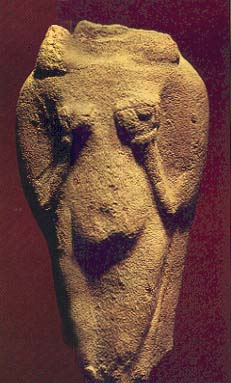
Another of our ivories is part of a handle carved in relief. The relief depicts a lioness with raised tail, crouched ready to spring.
Our most important artistic find from this period, however, is a limestone plaque portraying the head of a Phoenician noble (see cover photo). Carved in a style similar to that of contemporaneous ivories, our plaque was probably part of a complex scene that served as a wall decoration.
It was this city built by Ahab that fell to the Assyrians in 733 B.C.E.
MLA Citation
Footnotes
B.C.E. (Before the Common Era), used by this author, is the alternate designation corresponding to B.C. often used in scholarly literature.
See Ephraim Stern, “Excavations at Tell Mevorakh Are Prelude to Tell Dor Dig,” BAR 05:03.
See Neil Asher Silberman, “Glossary: A Question of Defense—Glacis, Casemate Wall and Offset-Inset Wall,” BAR 15:03.
There is, however, considerable dispute among archaeologists as to whether these buildings are stables or storehouses (see John O. Currid, “Puzzling Public Buildings,” BAR 18:01; see also “Megiddo Stables or Storehouses?” BAR 02:03, and Yigael Yadin, “In Defense of the Stables at Megiddo,” BAR 02:03. In my view, they were stables.
See Ephraim Stern, “What Happened to the Cult Figurines? Israelite Religion Purified After the Exile,” BAR 15:04).
See John C.H. Laughlin, “The Remarkable Discoveries at Tel Dan,” BAR 07:05; and Hershel Shanks, “Avraham Biran—Twenty Years of Digging at Tel Dan,” BAR 13:04.
Endnotes
See James B. Pritchard, ed., Ancient Near Eastern Texts Relating to the Old Testament, 3rd ed. (Princeton, NJ: Princeton Univ. Press, 1969), pp. 278–283.
Nahman Avigad, “A Hebrew Seal Depicting a Sailing Ship,” Bulletin of the American Schools of Oriental Research 246 (1982), pp. 59–61].


